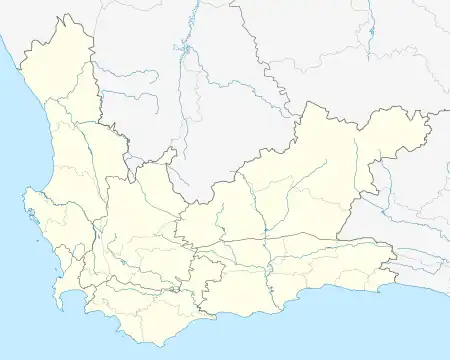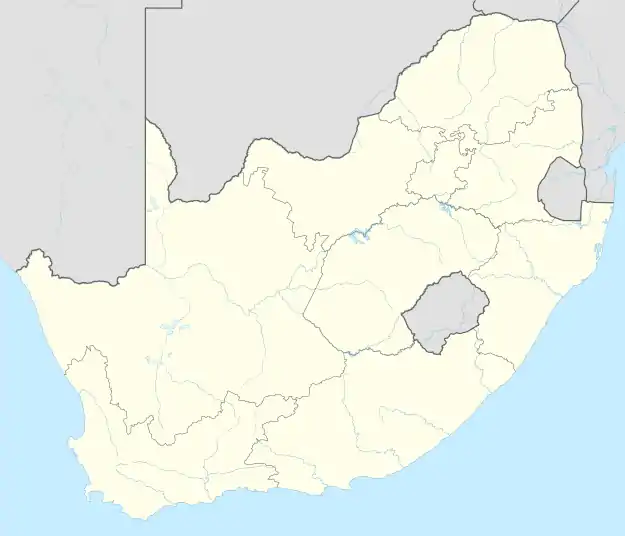Heidelberg | |
|---|---|
From top: Heidelberg Valley, left: Heidelberg Church, right: Welcome sign, left: Doornboom Opstal, right: Kweekkraal Cottage. | |
 Heidelberg  Heidelberg | |
| Coordinates: 34°05′S 20°57′E / 34.083°S 20.950°E | |
| Country | South Africa |
| Province | Western Cape |
| District | Garden Route |
| Municipality | Hessequa |
| Established | 1728 |
| Founded by | Louis Fourie |
| Area | |
| • Total | 23.69 km2 (9.15 sq mi) |
| Elevation | 84 m (276 ft) |
| Population (2011)[1] | |
| • Total | 8,259 |
| • Density | 350/km2 (900/sq mi) |
| Racial makeup (2011) | |
| • Black African | 9.3% |
| • Coloured | 75.3% |
| • Indian/Asian | 0.4% |
| • White | 14.4% |
| • Other | 0.6% |
| First languages (2011) | |
| • Afrikaans | 91.9% |
| • English | 3.4% |
| • Xhosa | 2.9% |
| • Other | 1.8% |
| Time zone | UTC+2 (SAST) |
| Postal code (street) | 6665 |
| PO box | 6665 |
| Area code | 028 |
Heidelberg is a town in the Western Cape, South Africa. It is located near South Africa's south coast, on the N2 highway, within the Hessequa region, 274 km east of Cape Town (about halfway between Cape Town and Knysna). Heidelberg marks the start of the Garden Route. Heidelberg is part of the Hessequa Local Municipality.
The historical Fourie House, dates back to the 1728, making it one of the oldest building in South Africa. This building yields national monument status.
As a tourist destination,[2] Heidelberg has several accommodation options, coffee shops, farm stalls, nature trails, mountain bike trails and art galleries. The Grootvadersbosch Nature Reserve, an indigenous forest with World Heritage Site status, is located 20 kilometers outside Heidelberg, and offers two forest hiking trails, camping site, glamping tents and self-catering cabins.
The Gysmanshoek Pass, is an old ox-wagon pass, and one of the lesser-known passes within the country. It offers a challenge for even 4x4 vehicles.
Annual events hosted in Heidelberg includes the Giant Pumpkin Festival (March / April), Silver Mountain Music Festival (June), Hessequa Harmonie (September), and the Vlakte Marathon (November).
History
In 1716, Louis Fourie (1690s–1767) obtained grazing rights from Governor van der Stel and he settled alongside the Duivenhoks River. This is where he later constructed the Doornboom Homestead - registered in 1728 - and the Doornboom Farm was established.
The area was initially part of the greater Riversdale district until the Riversdale Dutch Reformed church council in 1855 bought a portion of the farm Doornboom on which to lay out the town when a new Dutch Reformed congregation was created for the farmers between Swellendam and Riversdale.
The town grew around the church and it was named in honour of the German town, Heidelberg, because of the Heidelberg catechism that was practiced in the church.
In 1903 Heidelberg became part of the railway network and became an important transport link for the wool, wheat, fruit, and tobacco industries of the area. The river, the Duivenhoks (Dovecote), was named by an explorer, Isaq Schrijver, who observed a lot of doves where the river flows into the Indian Ocean, at a place called Puntjie.
 Dutch Reformed Church in Heidelberg
Dutch Reformed Church in Heidelberg Outlying Valley in Heidelberg. Western Cape
Outlying Valley in Heidelberg. Western Cape Fourie House / Doornboom Opstal. The oldest House in Heidelberg. Built in 1728
Fourie House / Doornboom Opstal. The oldest House in Heidelberg. Built in 1728

.jpg.webp)

.svg.png.webp)